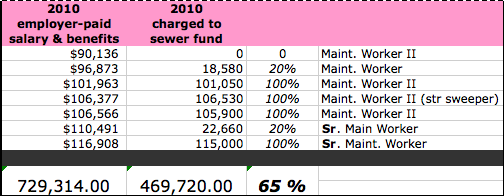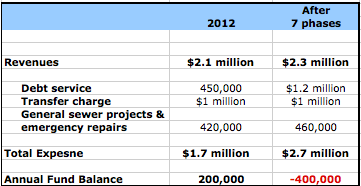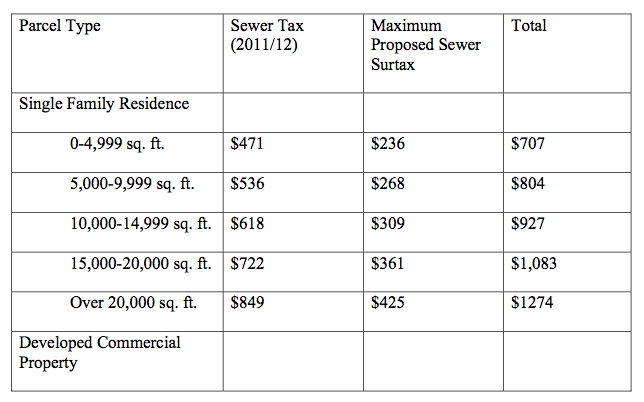Editorial: Confused Yet? PCA Explains Sewer Surcharge Issues
Hidden Choices: Draining the Sewer Fund to Fund General Fund Activities-
Where did the 2000 sewer tax increase go?
Replacement of Piedmont’s sewer mains has been a long-standing goal. In 2000 the sewer tax was almost tripled to pay for mains replacement. Where did the money go?
To date, the city has replaced 60% of its main sewer line. This was accomplished from 2000-2005 by tripling the sewer tax charge in 2000. Setting aside financial issues, every resident agrees it would be optimal to replace the remaining 40% of mains as quickly as possible. And it would be great if we had money in the bank (sewer fund) to do this. But the Sewer Fund has run short of funds to replace the remaining 40% of lines. This shortage exists with or without new EPA requirements for monitoring, reporting, and maintaining the sewer lines. Why is the sewer fund out of money to replace sewers?
Close to $1 million per year has been transferred out of the Sewer Fund to the General Fund in past years as the General Fund came under severe financial pressure.
The annual “transfer out” charge is intended to cover the cost of maintenance of the sewer system performed by city employees. However, documentation provided by staff suggests the charge does not correlate well to actual costs. Staff indicates that administrative and legal time may be understated in recent years, while the fund is charged for 100% of the time of 4 maintenance workers who spend only 50% of their time on sewers and storm drains. (See chart below.) In addition, it is possible a large portion of their maintenance time is devoted to storm drains, rather than sewers. Other minor charges (water service fees, equipment, etc.) have also been charged to the Sewer Fund.
To the extent Sewer Fund monies are used to fund general City maintenance tasks, they are unavailable for sewer replacement. To the extent the monies are used for non-sewer costs and activities, they are unavailable for sewer replacement.
By transferring $1 million out of the Sewer Fund to the General Fund annually, the Sewer Fund is supporting many General Fund activities which most residents would agree have much lower priority than sewer replacement – activities that could not garner the 2/3 approval of the voters.
The annual “transfer out” charge to the Sewer Fund could be reduced. It could even be reversed with a “transfer in,” as has occurred in past years. The level at which the “transfer out” charge is set represents a political, not staff, decision. If active consideration is not given to this charge each year, the Council is placing sewer mains replacement lower than every other General Fund expenditure. And the newly proposed proposed surcharge could be considered a request to fund, not sewer replacement, but lower priority items in the General Fund budget.
Is the Proposed Sewer Surcharge Funding Mains Replacement or Other Stuff?
Where will the proposed new sewer tax monies go?
Piedmont has self-selected a shorter period to complete its sewer rehabilitation than most other cities – 6 to 10 years. This shortened time line necessitates more taxpayer funding than an extended time line, but has advantages such as lower overall costs and reducing environmentally damaging spills into the Bay. Setting financial considerations aside, most residents would favor completing all necessary sewer replacement as soon as possible.
Unfortunately, the chart below shows that (with or without new EPA costs) current tax revenues for the Sewer Fund do not allow the City to complete rehabilitation on a 6-10 year timeline and, at the same time, continue to transfer out $1 million to the General Fund annually. (The chart ignores new EPA costs, which further increase, rather than cause, the predicted deficit.)
The Sewer Fund, as currently funded, will not have enough funds to complete the final 3 phases in 6-10 years due primarily to:
- Large annual “transfer out” charge against the Sewer Fund of approximately 50% – this charge drains funds from the Sewer Fund and transfers them to the General Fund. The charge against the sewer fund has risen to $1 million of its total $2 million revenues as the General Fund came under pressure in recent years. (See chart.)
- Substantial emergency repairs paid to private contractors – $2 million was expended during the 2 years from 2007 to 2009, depleting the sewer fund. This charge is normally in the range of $200,000 to 400,000 annually. Specifics on the expenditures have not been disseminated.
Sewer surcharge opponents point out that completing mains replacement in 6 to 10 years is not an EPA requirement (yet) and that the fund would not run out of money if the timeline for mains replacement completion is slowed down.
Piedmont’s most recent March 2011 Sanitary Sewer Maintenance Plans submitted to the EPA presents completion within 6-10 year as an “in house goal” rather than an EPA requirement. An EPA Compliance officer recently confirmed that:
“. . . the Stipulated Order does NOT specify a deadline by which Piedmont must complete the mainline sewer replacement work. NOR is there a stipulation for penalties to be assessed against Piedmont if they fail to replace or repair a certain length of pipe each year. “
Even if the sewer surcharge, Measure A, passes and the City chooses to submit (in July 2012) a formal timeline for completion of sewer mains replacement within 6-10 years, later deviations from the schedule will not automatically result in penalties – the City will have the opportunity to explain the deviation from the schedule it will submit in July 2012.
On the other hand, if the sewer tax fails, a less ambitious plan could be submitted in July, 2012 based on available funding. A close reading of statements from EPA officials confirms the City is obligated to submit a 10-year plan for mains replacement, not a plan to complete mains replacement within 10 years. Yet this distinction has often not been highlighted in media articles and discussions, confusing voters.
The minimum plan for mains replacement may have been identified by a City Consultant’s report on EPA 2011 AO-SO Cost Impacts. The consultant includes the need for mains replacement of 1% per year at a cost of $340,000 per year. (This EPA minimum would presumably continue until mains are replaced.) The sewer fund can afford this. But many residents favor the shortest financially feasible time frame. (For instance, the Municipal Tax Review Committee (MTRC) looked at speeding up the completion of mains replacement by undertaking one large final project rather than 3 phases, but this was not financially possible, even with the proposed sewer surcharge.)
The Sewer Fund, without the surcharge, should be able to support a plan for completion in approximately 11-15 years, since the cost of the debtservice from low-interest state loans for the initial 4 phases of rehabilitation will begin being retired as of 2023. Completing 1 or 2 of the last of 3 phases after 2023 would keep the City’s debt service costs well below the $1.2 million level that cause deficits in the Sewer Fund – without a new surcharge being necessary. The proposed surcharge is needed to complete work in the next 6-10 years – before debt service costs begin falling in 2023.







PCA deserves credit for providing such an in depth accounting of the requirements and costs of Measure A. The history leading up to Measure A is complex and voters should read the different PCA reports on this measure to make an informed vote. Since 2000, Piedmont has voluntarily replaced it sewer mains by collecting $1M annually with the sewer tax and that process is 60% completed. Because other cities have not kept pace, EPA issued the 2011 Stipulated Order requiring all East Bay cities to implement a sewer rehabilitation/monitoring program and Piedmont is included in that order. A recent letter from the EPA regional administrator outlined this program that consists mainly of flow monitoring and leak testing of older sewer systems. This monitoring program is designed for the leakier systems of the other East Bay cities, yet under it Piedmont will be monitoring its new sewer system, not the 40% remaining to be replaced. A key element of this rehabilitation/monitoring program is the requirement that cities annually replace at least 1% of their sewer mains each year. That rate is actually below the 4% replacement Piedmont currently achieves annually with the sewer tax.
What can lead to confusion is how the proposed measure integrates with the city’s replacement program funded by the sewer tax and what Piedmont is legally required to implement under the Stipulated Order. The Stipulated Order requires cities to implement a sewer replacement program, a program already in place in Piedmont. Can Piedmont implement the court-ordered monitoring program by using existing sewer tax revenues and not adopting the 50% surcharge? As the PCA analysis indicates, Measure A program costs could be covered by the existing sewer tax revenues. This would require slowing our voluntary replacement program. Since implementing our program in 2000, sewer spills in Piedmont have dropped to 3 a year, a 400% reduction. And the program has saved our best sewers for last so risk of major spills is declining.
There are three options available to the City at this point. One, full compliance with the Stipulated Order and full implementation of our replacement program which requires the adoption of Measure A. Two, slow Piedmont’s voluntary sewer replacement program so that the Measure A monitoring program is paid for with the existing sewer tax. Three, present EPA a sewer management plan that maintains the city’s replacement program with a reduced monitoring component. Whatever rehabilitation/monitoring plan Piedmont develops is not due to EPA until July of 2012 so voters can give clear direction to City Council on how to proceed with our submission to EPA.
Very interesting. Are all the problems and EPA-orders with the sanitary sewer system, the storm sewer(drain?)system or a combined system?
Was the sewer fund and tax set up to deal only with sanitary sewers?
Also please clarify the following: “This shortened time line necessitates more taxpayer funding than an extended time line, but has advantages such as lower overall costs and reducing environmentally damaging spills into the Bay.” I do not understand how “more taxpayer spending” is related “to lower overall costs”. Do you mean more taxpayer spending in the shorter term vs. the long term?
And “The Sewer Fund, without the surcharge, should be able to support a plan for completion in approximately 11-15 years, since the cost of the debt service from low-interest state loans for the initial 4 phases of rehabilitation will begin being retired as of 2023.” Does this assume no future transfers of sewer funds to the General Fund?
Thanks for trying to clarify a very murky subject.
Jack Follick
Thank you for the good job reporting on this.
BEST RESEARCHED ARTICLE OF ANY TOPIC EVER! Congratulations.
More, more, more…
where is money to fix broken curbs, resurface cracked/eroding streets (100 bl of Olive Ave.(on a slope, erodes)? It was was resurfaced partially in 1995 after sewer changed & only patched prior to centennial celebration in 2006. The patches are cracked through & holes are everywhere. Does the money go for beautification, ’cause there are always new flowers but the streets/curbs (in lower Piedmont) are not looked at.
Much thanks to PCA for some sharp investigation work and concise reporting! The following link helps PCA readers gain a further understanding and has some of the significant EPA emails:
http://piedmont.patch.com/articles/letter-to-the-editor-commenting-on-piedmont-post-article-on-measure-a
Kudos for the well-reasoned and well supported analysis, and thanks also to Council member Keating for his thoughtful response, which provided further clarity.
“A camera inspection completed in 2008 showed the need to continue sewer replacement for the last 40% of remaining lines, even though they are in better shape than the 60% already replaced.”
That camera survey was undertaken to prioritize the remaining sub-basins (40%) for the replacement program and the results have not analyzed to show that all sub-basins are in need of immediate repair. For example, one of the remaining sub-basins is the St James neighborhood which consists of much newer housing stock and presumably newer sewer systems. Residents in the remaining 40% of course want their sewers upgraded but may consider the extra tax at this time not worth it. Mainline replacement will continue with or without passage of Measure A.
Another issue related to the EPA order is private sewer lateral testing and replacement. Residents selling their homes will be required to test their sewer laterals and to replace them if they fail the test – a cost of $4000 and up. Homeowners whose private laterals fail during the testing of city sewer system may also be required to repair their sewer laterals. The proposed smoke testing of the city’s sewers will be conducted on the recently repaired 60% of the system, not the remaining 40%, so leaky private laterals will be identified during mainline testing.